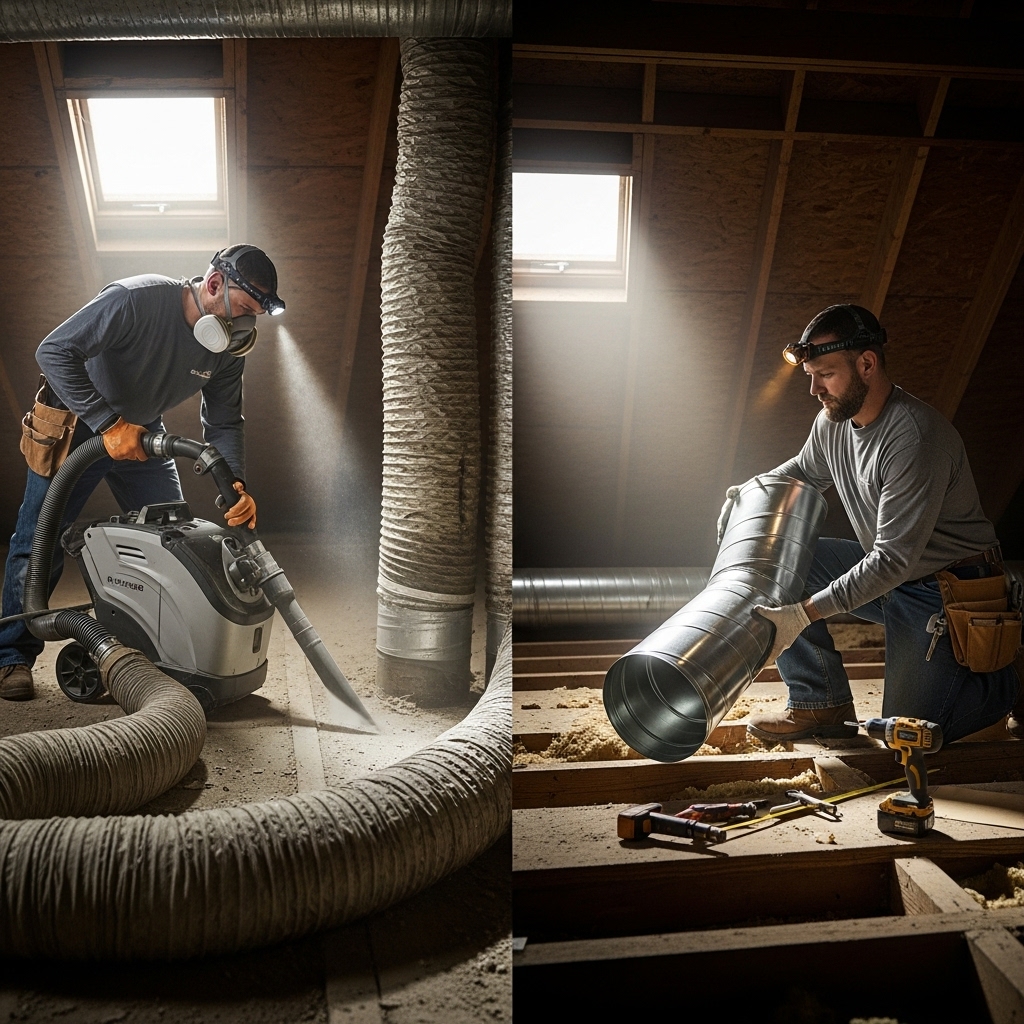Air Duct Cleaning vs Replacement in Malibu: Making the Right Choice
When temperatures climb in the San Fernando Valley and your HVAC system works overtime, the condition of your ductwork becomes a major factor in how comfortable and clean your indoor air feels. If you notice dust around registers, musty odors, uneven temperatures, or noisy airflow, you may wonder whether professional cleaning is enough or if full replacement is the better path. The answer depends on the condition, design, and age of your ducts, along with your goals for comfort and indoor air quality. This guide explains how to evaluate your situation, what each option can and cannot accomplish, and how a thoughtful assessment leads to the best outcome. If you are beginning your research, you will find clear criteria that point you toward cleaning, replacement, or a hybrid approach. Along the way, we will outline where high-quality duct replacement delivers benefits that cleaning alone cannot achieve.
Malibu homes often rely on attic duct runs exposed to high heat for much of the year. Dust and fine particulates can accumulate in older or leaky systems, and poor design can cause rooms to run hot or cold regardless of how often you clean. The goal is not to pick one option blindly but to identify what will resolve the root cause of your symptoms while aligning with local conditions and best practices.
What Duct Cleaning Can Do
Professional duct cleaning focuses on removing accumulated dust and debris from the interior surfaces of your ducts and components such as registers and returns. When performed carefully and in the right circumstances, cleaning can help reduce recirculating dust and odors. For relatively modern, well-sealed duct systems without significant damage, a thorough cleaning paired with improved filtration may noticeably improve air freshness.
- Helps when dust buildup is present but duct materials are intact.
- Can reduce odors associated with dust and minor contaminants.
- Works best when ducts are properly sealed to prevent recontamination.
- Should be combined with high-quality filtration to maintain benefits.
What Duct Cleaning Cannot Do
Cleaning does not correct structural or design problems. If ducts are undersized, crushed, disconnected, or contaminated by moisture and microbial growth, cleaning will not solve the root cause. Nor will cleaning fix loud airflow caused by high static pressure or poorly designed return paths. In other words, cleaning is maintenance, not a structural remedy.
When Duct Replacement Makes Sense
Replacement addresses systemic issues that cleaning cannot. If your home has widespread leakage, deteriorated insulation, crushed or kinked runs, or an outdated layout that leaves rooms uncomfortable, new ducts allow a fresh start. Replacement opens the door to proper sizing, balanced returns, smooth airflow paths, and careful sealing and insulation. For homes with porous duct materials that have sustained contamination or damage, replacement is often the most reliable path to long-term cleanliness and performance.
- Resolves damaged or contaminated sections that should not be reused.
- Allows redesign for even temperatures and lower noise.
- Enables comprehensive sealing and insulation to match Malibu conditions.
- Supports accurate testing and balancing for verified results.
Diagnostic Steps to Decide Between Cleaning and Replacement
A professional evaluation should include visual inspection (often with cameras), airflow and static pressure measurements, and a review of return strategies. These steps help determine whether your issues stem mainly from dirt and dust accumulation, structural damage, or design constraints. Ask your evaluator to document findings and connect them to recommended actions so you can weigh options with confidence.
Key Questions to Ask
- Are my ducts structurally sound and appropriately sized?
- Is there evidence of moisture, microbial growth, or damaged insulation?
- Do certain rooms remain uncomfortable even after filter changes and routine maintenance?
- Are return paths adequate for how we use the home?
- Will cleaning address my symptoms, or do design and condition issues point to replacement?
Comfort and Noise Considerations
Comfort and noise are not just about cleanliness. Undersized or poorly routed ducts force air to move too quickly, creating whistling registers and uneven temperatures. Cleaning the interior won’t change the physical path or capacity of your ducts. Replacement, on the other hand, can right-size branches, smooth elbows, and align registers with room layouts to reduce turbulence and noise.
Indoor Air Quality: Cleanliness Meets Design
Healthy indoor air depends on more than clean duct interiors. Sealed connections, appropriate filtration, and balanced returns are necessary to minimize dust recirculation and pressure imbalances that pull unfiltered air from attics or crawlspaces. Replacement allows a comprehensive approach: clean materials, tight sealing, and filter access that encourages regular maintenance. Cleaning can be part of a maintenance plan for otherwise sound systems, but replacement is the path to a clean slate when materials are compromised.
Local Considerations in Malibu
Attic temperatures in Malibu spike during the summer, and wildfires in surrounding areas can occasionally introduce fine particulates into the air. Ducts that leak or are poorly insulated can allow particulates and heat to degrade indoor conditions. Replacement provides the opportunity to revisit insulation levels and sealing standards for ducts routed through hot spaces, while cleaning focuses on internal surfaces without changing thermal or leakage characteristics.
Hybrid Approaches: Where Cleaning and Replacement Meet
Sometimes the best path blends targeted replacement with cleaning. For example, if several branches are crushed or contaminated but the main trunk is sound, a contractor may recommend replacing the damaged branches, improving returns, sealing all connections, and then cleaning the remaining sections. This approach addresses root causes while preserving materials that still perform well.
What a Thorough Replacement Entails
A well-executed replacement starts with layout verification and careful removal of old materials. New trunks and branches are installed with appropriate supports, gentle bends, and tight connections sealed with mastic. Boots are aligned to registers, returns are configured for even circulation, and the entire system is insulated to meet local conditions. Technicians then measure airflow and static pressure and balance dampers to fine-tune comfort. This process transforms both cleanliness and performance in ways that cleaning alone cannot match for an aging or damaged system.
What a Thorough Cleaning Entails
Professional cleaning includes protecting your home, removing registers and grilles, agitating and capturing dust with specialized tools, and ensuring the air handler and return paths are addressed. The crew should avoid damaging duct materials and should seal access points properly after the service. Without good filtration and sealing, however, the benefits of cleaning can fade as dust reaccumulates.
Middle-of-Project Considerations
Whether cleaning or replacing, communication is essential. If technicians find hidden damage, moisture, or blockages, they should document the issue and explain options. Clear documentation helps you decide whether to expand the scope—such as replacing a compromised return—so that your investment delivers the results you expect from your air duct replacement or cleaning service.
Signs You May Need More Than Cleaning
- Persistent hot and cold spots despite regular maintenance.
- Visible duct damage, crushed sections, or disconnected runs.
- Musty odors or signs of moisture intrusion.
- Excessive noise from registers or the air handler.
- Old ducts with outdated materials or poor insulation.
Frequently Asked Questions
Q: How often should ducts be cleaned? A: There is no universal schedule. Cleaning is best driven by inspection findings, indoor air quality concerns, and any events that introduce unusual dust or debris.
Q: Can cleaning fix uncomfortable rooms? A: Not if the cause is design-related. Undersized or poorly routed ducts require redesign or replacement to resolve comfort issues.
Q: Will replacement make the system quieter? A: Yes, when it includes correct sizing, smooth airflow paths, and balancing. These steps reduce turbulence and whistling.
Q: Is partial replacement a good idea? A: It can be. Replacing damaged sections and addressing returns while cleaning sound sections can strike a sensible balance.
Q: How long will I be without heating or cooling? A: Downtime depends on the scope of work. Contractors can often plan phases to minimize disruption.
Preparing for Either Option
- Clear access to attics, crawlspaces, and mechanical areas.
- Discuss how technicians will protect floors and furnishings.
- Plan for pets and household routines during the work.
- Ask for before-and-after documentation to verify results.
Choose with Confidence
Cleaning is effective maintenance for structurally sound ducts, while replacement solves long-standing performance and cleanliness problems. With a careful evaluation and a clear plan, you can choose the option that aligns with your goals for comfort, noise, and indoor air quality.
Make Your Next Step Count
If you are ready to solve persistent comfort and cleanliness issues, schedule a professional evaluation that weighs cleaning against replacement with your home’s conditions in mind. Invest in a plan that delivers lasting results through correct sizing, sealing, insulation, and testing supported by expert duct replacement when it is the right solution.

